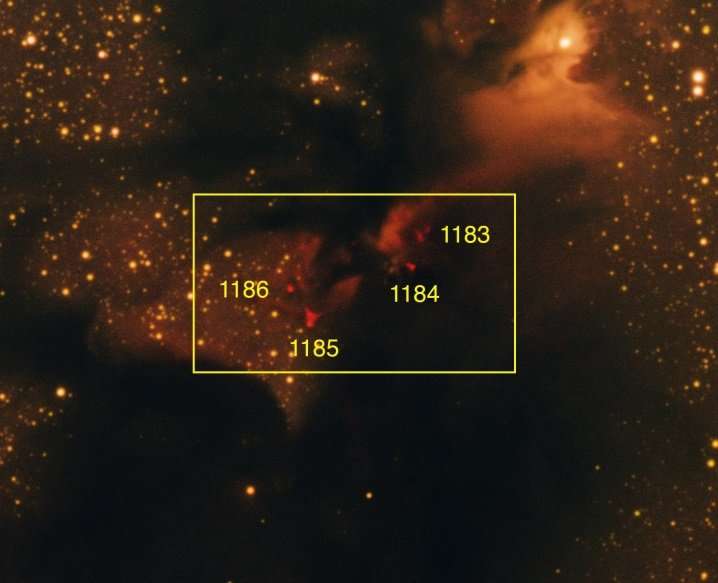December 11, 2017 report
Astronomers identify twelve new Herbig-Haro objects in the dark nebula LDN 673

(Phys.org)—Astronomers have found a dozen new faint Herbig-Haro objects in the dark nebula LDN 673 by employing a novel color-composite imaging method. The discovery, reported in a paper published December 1 on the arXiv pre-print server, could provide new important information about star formation process.
Located some 650 light years away from the Earth, Lynds' Dark Nebula 673 (or LDN 673 for short) is a very dense, highly fractured dark cloud complex in the Aquila Rift region. Astronomers believe that LDN 673 contains raw material to form a huge number of new stars, and therefore could offer some hints about the process of stellar formation. Although this nebula is relatively close, it has not been extensively studied yet.
Recently, a team of astronomers led by Travis Rector of the University of Alaska Anchorage has observed LDN 673 with the aim of learning more insights into the nature and composition of this nebula. They used a novel color-composite imaging method utilizing the MOSAIC optical camera on the Mayall 4-meter telescope at Kitt Peak National Observatory (KPNO), located on Kitt Peak in Arizona.
They found the so-called Herbig-Haro (HH) objects, small patches of nebulosity associated with newly born stars. They are produced by shocks from the collision of an outflow with material in the interstellar medium, or with previously ejected outflows. HH objects are perceived by astronomers as markers for active, ongoing star formation and could improve our knowledge about this process.
"In this paper we report on the discovery of twelve HH objects in the region of LDN 673," the researchers wrote in the paper.
According to the study, four of the newly detected HH objects, designated HH 1183–1186, are likely associated with a cluster of eight young stellar object (YSO) class I/II red infrared sources that lie between them. Five other HH objects, named HH 1187–1191, are quite faint and are likely also associated with the young T Tauri star multiple AS 353. The remaining three, known as HH 1192-1194, are bisected by a very red source that coincides with an infrared dark cloud.
Given that HH objects are tracers of the powerful outflows common to the youngest generation of young stars, the researchers emphasized that their discovery delivers evidence of new and ongoing star formation in the Aquila region and suggest the existence of a larger T Tauri population there. They added that the finding gives hope for more promising results in the future when it comes to detecting new young stars.
"Examination of broad survey data in the region, such as 2MASS, UKIDDS, and WISE, and detailed analyses of color data may reveal more extensive young star populations. There is particular appeal to the possibility of a substantial young star population in Aquila as the region is less than 300 pc away, providing a nearby population of young stars available for unprecedentedly sensitive and detailed study in the ALMA/JWST era," the paper reads.
More information: The Discovery of Herbig-Haro Objects in LDN 673, arXiv:1712.00305 [astro-ph.SR] arxiv.org/abs/1712.00305
Abstract
We report the discovery of twelve faint Herbig-Haro (HH) objects in LDN 673 found using a novel color-composite imaging method that reveals faint H{alpha} emission in complex environments. Follow-up observations in [S II] confirmed their classification as HH objects. Potential driving sources are identified from the Spitzer c2d Legacy Program catalog and other infrared observations. The twelve new HH objects can be divided into three groups: Four are likely associated with a cluster of eight YSO class I/II IR sources that lie between them; five are colinear with the T Tauri multiple star system AS 353, and are likely driven by the same source as HH 32 and HH 332; three are bisected by a very red source that coincides with an infrared dark cloud. We also provide updated coordinates for the three components of HH 332. Inaccurate numbers were given for this object in the discovery paper. The discovery of HH objects and associated driving sources in this region provides new evidence for star formation in the Aquila clouds, implying a much larger T Tauri population in a seldom-studied region.
© 2017 Phys.org





















